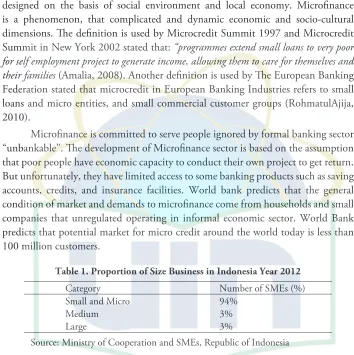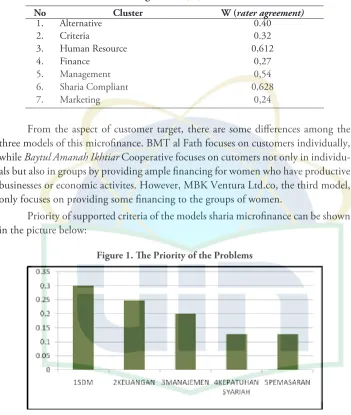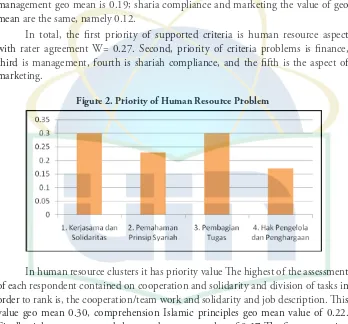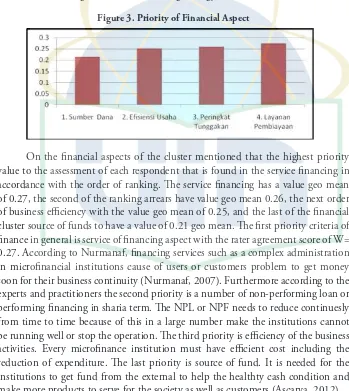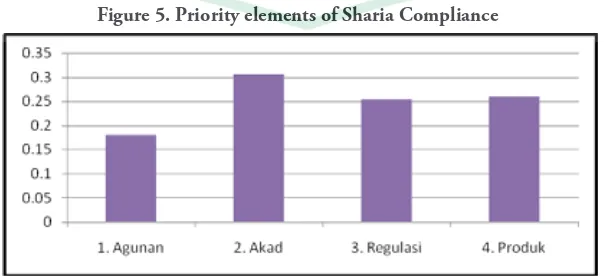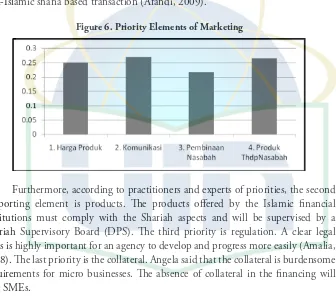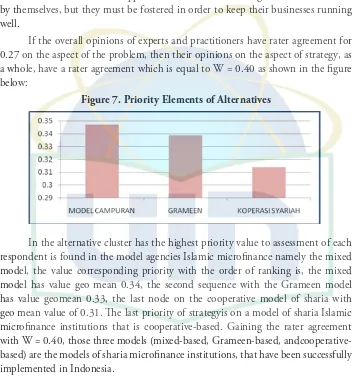EVALUATING THE MODELS OF SHARIA MICROFINANCE
IN INDONESIA: AN ANALYTICAL NETWORK PROCESS
(ANP) APPROACH
Euis Amalia & Mahmudah Atiqah1
Abstract. Evaluating he Models of Sharia Microinance in Indonesia: An Analytical Network Process (ANP) Approach. his study focuses on evaluating the performances of three sharia microinance models, i.e. cooperative model represented by BMT al Fath, Grameen model represented by MBK, Ltd.co, and mixed model represented by Baytul Amanah Ikhtiar cooperative. ANP approach is used to evaluate the performances of those models from ive important aspects (clusters) as the determiners, such as human resource, inance, management, sharia compliance, and marketing. he indings of this research show that the most important aspect (priority) among the clusters is human resource. hus, the best strategy is the mixed-based; the model which integrates the cooperative system with grameen system. It becomes the best model inasmuch as it implements values of both co ownership and co responsibility, in addition to power of collectivity resulting in no cash collateral.
Keywords: Sharia Microinance, Performance, ANP, Strategy
Abstrak. Evaluasi Model Keuangan Mikro Syariah di Indonesia: Suatu Pendekatan ANP. Fokus dari kajian ini ialah untuk melakukan evaluasi atas tiga model keuangan mikro syariah, yaitu model koperasi yang direpresentasikan oleh BMT Al-Fath, model Grameen yang direpresentasikan oleh MBK, Ltd. co, dan model campuran yang direpresentasikan oleh koperasi Baytul Amanah Ikhtiar. Pendekatan ANP dipergunakan untuk evaluasi atas kinerja dalam model ini pada lima aspek utama yaitu sumber daya manusia, keuangan, manajemen, kepatuhan syariah, dan pemasaran. Temuan dari kajian ini menunjukkan bahwa aspek yang paling penting antar kluster ialah sumber daya manusia, dan strategi terbaik yang dipergunakan strategi campuran, yaitu yang mengintegrasikan sistem koperasi dengan sistem grameen. Hal ini menjadi model yang terbaik untuk diimplementasikan dalam keuangan mikro syariah.
Kata Kunci: keuangan mikro syariah, kinerja, ANP, strategi
First draft: September, 12th 2014, Revision: November, 5th 2014, Accepted: December, 5th 2014
1 Syarif Hidayatullah State Islamic University. Jl. Ir. H. Juanda No. 95, Ciputat, South Tangerang, Banten, Indonesia.
Introduction
Economic activity will not be separated from human life. From the point of view of the jurisprudence science, economic activities not included chapter worships, but muamalah chapter. National economic conditions are still recovering today that have an impact on the diiculty or fear in the form of bank inancial institutions for lending, especially for the development of the real sector in small land medium scale. Currently, the most dominating economic problem is poverty. One of the main causes of poverty indeveloping countries is the lack of access to productive capital (Todaro, 2009). Indonesian economy not only face structural imbalances in the acquisition of value-added and employment among sectors but also face the added value inequality between actors or between group scale economic activities and sectors (Amalia, 2008).
Indonesia must ind a way out quicly in some strategies, one of them is the reinforcement various aspects of the Micro sector and Small Enterprises (SMEs) which have important role as a major source of employment and income in developing countries (Arsyad, 2008). In addition to proven current global crisis sometimes ago, SMEs present as a solution of the system.
A healthy economy is when the industrial sector little or not at all afected by the global crisis sweeping the world. With this evidence, it is clear that SMEs can be taken into account in increasing competition in the market and stabilization of the existing economic systems in Indonesia. SMEs development is the main priority of the Government in Indonesia (Hill, 2001). Diiculty capital became a major issue in the developmentof SMEs. Community Under almost untouchable (underserved) and it is not considered to have potential funding by formal inancial institutions like banks, so it causes an stunted economic acceleration.
Literature Review
Microinance institution is indicated by regulations, innovation, and lexibility designed on the basis of social environment and local economy. Microinance is a phenomenon, that complicated and dynamic economic and socio-cultural dimensions. he deinition is used by Microcredit Summit 1997 and Microcredit Summit in New York 2002 stated that: “programmes extend small loans to very poor for self employment project to generate income, allowing them to care for themselves and their families (Amalia, 2008). Another deinition is used by he European Banking Federation stated that microcredit in European Banking Industries refers to small loans and micro entities, and small commercial customer groups (RohmatulAjija, 2010).
Microinance is committed to serve people ignored by formal banking sector “unbankable”. he development of Microinance sector is based on the assumption that poor people have economic capacity to conduct their own project to get return. But unfortunately, they have limited access to some banking products such as saving accounts, credits, and insurance facilities. World bank predicts that the general condition of market and demands to microinance come from households and small companies that unregulated operating in informal economic sector. World Bank predicts that potential market for micro credit around the world today is less than 100 million customers.
Table 1. Proportion of Size Business in Indonesia Year 2012
Category Number of SMEs (%)
Small and Micro 94%
Medium 3%
Large 3%
Source: Ministry of Cooperation and SMEs, Republic of Indonesia
Based on that data, it is clear that small medium enterprises or SMEs are very potential in economic world. he general condition of informal sectors are often described as an institution that has a limited access to capital. It is owned or managed by a family, which is usually small scale and no legals, is running in unregulated markets that is easy to escape from the market, employs tons of people who usually have lower education and limited skills (Edratna, 2013).
herefore, it can be classiied that SMEs are based on the number of employees, the rate of income, and the size of asset. According to Hubeis (2009), SMEs are deined in many diferent ways depending on the countries and other aspects.
conventional-based model. he sharia-based microinance is mostly set up in the form of Baitul Maal wa Tamwil (BMT) operating normaly like other Sharia banks. However, it is running legally under the cooperative regulation on the basis of Act No 25 year 1992 about cooperative rules and PP No. 9 year 1995 which rules the saving and credit cooperative businesses. herefore, BMT has similar products to the ones that Sharia banks have. Yet it is diferent from the amount of inancing that away less than the Sharia banks can provide (Baihaqi, 2000). In Some cases, there is another kind of BMT operating with totally pure cooperative system. All the cooperative terms are used for its products such as basic contribution/deposit, obligatory deposit, and voluntary deposit. his is of course the kind of BMT also runs under the same cooperative regulations. On the other hand, microinance in Indonesia either conventional or sharia also can operate grameen model under a venture capital company legally running under No.18/PMK 010/2012. Recently, a brand new regulation has just been released in act No. 1 year 2013 about microinance institutions. It regulates that all microinance models must have an operation licence from the Financial Services Authority, both in running with cooperative legals or company. Nevertheless, the position of microinance nowadays in Indonesia is still debatable depending on the interests, needs, motives, and purposes of stakeholders. Consequently, it is not focusing on regulation issue only.
Shariah microinance institutions appeared in reality as a social business model movement which rapidly develops in Indonesia. here are at least three models of this microinance; irstly - BMT running with a cooperative model, secondly - microinance institution operating with a grameen model, and thirdly - the one operating with both cooperative and grameen model, called mixed microinance model.In practice,those three models operate with shariah principles such as fairness (Amalia, 2008), cooperation (Alma, 2005), transparency (Daniri, 2005), and, universal values such as prohibition of interest, gambling, speculation activities, and other harmfull activities. In operating this microinance,those institutions are similar to the banks in terms of funding, inancing and other kinds of services ofered to their customers.
Table 2. he Comparison of hree Sharia Microinace Models
No Speciication Sharia Microinace Models
Grameen Cooperative Mixed
3. Products Proit Sharing
he following are the three models of microinance, which become the object of research in this paper: irst, sharia microinance as cooperative represented by BMT al Fath. Besides implementing the sharia principles, this model uses special cooperative terms for its products and management. In terms of inancing, this model provides the credits to individuals, not groups. Second, Sharia microinance operating with grameen model.his model which has been succesful in Bangladesh is triggered and led by Muhammad Yunuswho has won an a Nobel awards. he basic principle of Grameen model is inancing the small groups particularly groups of lower-income or poor women who have the ability to conduct any productive economic activity. In Indonesia, PT MBK Ventura is one sample that totally adopts this grameen system eventhough it integrates this grameen system with sharia principles. hird, mixed-model microinance is a combination between cooperative and grameen model. Koperasi Baytul Ikhtiar (BAIK) is a shariah microinance institution which is implemented this model; on one side, it operates using the terms and management of cooperative. However, it also implements the inancing program for small groups of women as it is developed by grameen system.
aspects, target of customers, products, size of inancing, operation systems or type of inancing transaction, irst amount of inancing, and monitoring programs. hose three models have both diferences and similiraties.
Furthermore, in term of performance, any institutionshould have a certain standard as indicators to measure its development and sustainability. his study elaborates some factors that may afect the performance of a microinance institution, as well as the indicators found for evaluating the models. he factors are human resource, inance (Robbin and Coulter, 2012), management (Robbin and Coulter, 2012), sharia compliance, and marketing, including both spiritual aspect and material aspect.
Methods
To evaluate and analyze the inding of research, Analytic Network Process (ANP) is used as the study approachment and measurement of some criteria (Ascarya and Cahyono, 2010). he approace will identify and classify three models of sharia microinance into 5 clusters that each of them has 4 main aspects of category. he criteria of clusters are divided into human resources, inance, management, sharia compliance, and marketing. In human resource, there are have 4 main aspects such as cooperation, solidarity sharia principles knowledge and division of the obligations including the rights of oicer and reward for the empoloyee.
In inance cluster, there are source of fund, eiency of cost, rate of late payment or non-performing loan, and inancing service. he third cluster is management which has the followingfour main aspects: irst, institution; second, standard operating management; third, standard operating procedures; fourth, technology. In the cluster of Sharia Compliance, the 4 main aspects comprise include; collateral type of transactions regulation and product. he last cluster is marketing that consists of these main aspects: irst, price; second, communication; third, assistancy of the customers; fourth, quality of the products.
ensure that all the results are correct by validating every single procedure. At this stage, the concordance of Kendall’s Coefeciency is possible to be calculated to see the aggrement among respondents. Eventually, either the speciic interpretation (individuals) or overall interpretation (geometric mean) can obviously be identiied and concluded.
Geometric Mean describes the priority of results from respective clusters and criteria or nodes. hese results are in the form of the most important priority of others. he calculating the geometric mean is used to ind out the individual judgment among respondents and to determine the results of group’s evaluation or perception (Rusydiana and Devi, 2010). he questions from respondents will be combined and compared to the form an agreement. Geometric Mean is an average scoring system showing tendencies or certain scores with the following formulation (Ascarya, 2012):
GMk = (R1*R2*...*Rn) 1N GM = Geometric Mean R = Responden
N = Number ofRespondens
After counting the geometric mean, agreement rater can be calculated. Value of rater agreement as a measure shows asuitable degree among respondents (R1-Rn) toward problem in a cluster. he measure formula to get the rater agreement is Kendall’s Coicient of Concordance (W; 0< W < 1). W=1. W=1 which shows the perfect suitability. he next step is inding rater agreements such as,transpose ranking counted by ordering normalized value from the biggest to the smallest and then to sum, to count W. If the score of appraisal W is 1 (W=1), it means that perception or opinion from respondents is perfect suitability. Nevertheless, when the score W is 0 or is closed to 0, it means that there is no suitability among the answers from respondents or more various answer.
Discussion
Based on the indings of research, it can be concluded that the three models of sharia microinance institutions (i.e. Sharia Cooperative model, Grameen Model, and Mixed Model) have their own operating systems and prosedures. BMT al Fath and Baytul Amanah Ikhtiar with cooperative legals declare that the ownership and responsibility of the institution belong to all of members, while the Grameen Model of MBK Ventura Ltd.co with corporation legals declares that the ownership and responsibility of the company belong to shareholders.
Table 3. Score of Rater Agreement (W) in All of Clusters of ANP
No Cluster W (rater agreement)
1. Alternative 0.40
2. Criteria 0.32
3. Human Resource 0,612
4. Finance 0,27
5. Management 0,54
6. Sharia Compliant 0,628
7. Marketing 0,24
From the aspect of customer target, there are some diferences among the three models of this microinance. BMT al Fath focuses on customers individually, while Baytul Amanah Ikhtiar Cooperative focuses on cutomers not only in individu-als but individu-also in groups by providing ample inancing for women who have productive businesses or economic activites. However, MBK Ventura Ltd.co, the third model, only focuses on providing some inancing to the groups of women.
Priority of supported criteria of the models sharia microinance can be shown in the picture below:
Figure 1. he Priority of the Problems
sharia-based transactions such as proit sharing (mudaharabah and musyarakah), sales (bay’ murabahah), and others that embrace sharia principles. In addition, BMT Baytul Ikhtiar and MBK Ventura provide special assistance, guidance, or mentoring for their customers or members.
he highest priority assessment of each respondent on supporting existing criteria on aspects of human resources in accordance with the order of ranking are, the value of human resources geo mean 0.29; 0.24 geo mean inancial value; value management geo mean is 0.19; sharia compliance and marketing the value of geo mean are the same, namely 0.12.
In total, the irst priority of supported criteria is human resource aspect with rater agreement W= 0.27. Second, priority of criteria problems is inance, third is management, fourth is shariah compliance, and the ifth is the aspect of marketing.
Figure 2. Priority of Human Resource Problem
or in one oicer than others (SOP KJKS, 2012). According to the experts and praticioners the second priority is human resources or their employee perception of sharia principles. Knowing of oicer of microinance institutions should be best in sharia pinciples knowledge otherwise it inluences the institution’s reputation and lack of participation of all members. In the last priority is the rights and award for the employees. All employees of the institutions need to receive proper wage or salary for their welfare and prosperity as well as important to give award for the oicer or employee who has a good performance or achieve of the targets. his way can be encouraging for themselves and other persons in work and inluencing for the creative thinking and skill in marketing strategy.
Figure 3. Priority of Financial Aspect
Figure 4. Priority Management Elements
In the cluster management aspects, the highest priority value to the assessment of each respondent is found in the standard operational procedures in accordance with the order of ranking, the standard operating procedure value is 0.30 geo mean, the second order of the operational standards of management geo mean value of 0.27, next institutional geo mean value of 0.23, the last of the cluster management technology with a value of 0.19 geo mean. On the management element, the irst priority is problem criteria which discusses the aspect of Standard of Operating Procedure (SOP) with rater agreement W = 0.54. Exellent and detailed SOP will assist an organization in operation and will be a guide in operating various policies and regulations related to the management of the institution, as described on the Standard of Operating Management (SOM) (SOP KJKS, 2012). Furthermore, practitioners and experts agree that the second priority is Standard of Operating Management (SOM). According to the SOP of Islamic inancial services cooperative, SOM is a task structure, working procedures, management systems and standards of work that can be used as a guide for the management to provide good services. he third priority is the institution. An institution with social capital has an enormous inluence on the environment. Hence, the institution needs to be strengthened. he last priority is technology. Better technology will make the operations easier and faster.
Incompliance aspects of sharia cluster has the highest priority value to the assessment of each respondent that is found in the contract of inancial institutions in accordance with the value of the priority ranking order is, on aspects of the contract has a value of 0.30 geo mean, the second order of the views of the product given a value of 0.26 geo mean, the regulation with geo mean value of 0.25, the last of the collateral cluster sharia compliance with geo mean value of 0.18. In complying with elements of sharia, the irst priority is the ratio of rater agreement contract with W = 0.628. Every contract was made by the Islamic microinance institutions should be based on sharia. he irst contract agreed will determine whether it is a sharia or non-Islamic sharia based transaction (Afandi, 2009).
Figure 6. Priority Elements of Marketing
Furthermore, according to practitioners and experts of priorities, the second supporting element is products. he products ofered by the Islamic inancial institutions must comply with the Shariah aspects and will be supervised by a Shariah Supervisory Board (DPS). he third priority is regulation. A clear legal basis is highly important for an agency to develop and progress more easily (Amalia, 2008). he last priority is the collateral. Angela said that the collateral is burdensome requirements for micro businesses. he absence of collateral in the inancing will ease SMEs.
slight diference among the priorities.he irst priority is product quality that should always be customized by the customers’ needs. he third priority is that the price of the product ofered must be appropriate and afordable for customers. he last priority is providing guidance especially for clients who have been able to sustain their bussinesses. Supporting the statement, M. Asdar said that customers who have been recruited are not supposed to be left alone running their own businesses by themselves, but they must be fostered in order to keep their businesses running well.
If the overall opinions of experts and practitioners have rater agreement for 0.27 on the aspect of the problem, then their opinions on the aspect of strategy, as a whole, have a rater agreement which is equal to W = 0.40 as shown in the igure below:
Figure 7. Priority Elements of Alternatives
In the alternative cluster has the highest priority value to assessment of each respondent is found in the model agencies Islamic microinance namely the mixed model, the value corresponding priority with the order of ranking is, the mixed model has value geo mean 0.34, the second sequence with the Grameen model has value geomean 0.33, the last node on the cooperative model of sharia with geo mean value of 0.31. he last priority of strategyis on a model of sharia Islamic microinance institutions that is cooperative-based. Gaining the rater agreement with W = 0.40, those three models (mixed-based, Grameen-based, andcooperative-based) are the models of sharia microinance institutions, that have been successfully implemented in Indonesia.
time in community, especially in Bangladesh. For the very irst time, this system was introduced in Bangladesh by Muhammad Yunus. According to Mahmud Toha, the role and efectiveness of the Grameen Bank model have their own appeal in the ease of the procedures and installment loans, relatively low interest rate, and last but not least, the convenience, attention, guidance, and marketing support given to the whole members (Toha, 2000). Consequently, it is more than just cooperative model that has long been in society and that applies the concept of cooperative savings and loans, and more than just the Grameen model that only applies its inance concept.
Microinance becomes the most important factor in poverty reduction, especially in Indonesia. he number of small and micro enterprises reaches around 99.39 %. It is very signiicant compared to the large and medium-sized businesses. From those data, it can clearly be seen that small and micro enterprises have an important role in the development and the growth of economy, not only in developing countries but also in developed countries. Many institutions provide microinance services for small enterprises, not only Islamic banking but also followed by many non-bank Islamic inancial institutions operating in the micro sectors. Islamic microinance institutions based on proit and loss sharing or based on sharia is a reality that has been growing rapidly in Indonesia.
In support of the development of Sharia microinance institutions, the presence of an appropriate model of institution is required for strengthening the micro sector in Indonesia. Based on the indings of research conducted with the approach of the Analytic Network Process (ANP) toward the practitioners and experts of micro enterprises, strategic prioritiesof every element have been identiied, namely: irst, mixed-based models of Sharia microinance institutions; second, Grameen-based models of Islamic microinance institution; and third, models of Islamic microinance institutions in the form Sharia cooperatives.
he indings of ANP show that the mixed-based model of Islamic microinance institutions is the most appropriate model to encourage the real sector in Indonesia. he model integrates two systems in operation; sharia cooperative system and Grameensystem (group inancing).
be applied in Indonesia, in comparisonto the Grameen model and sharia cooperative model.
Based on the ANP, the mixed-based model of Sharia microinance institutions is encouraged by various aspects of supporting priorities.
First: Human Resources (HR). he core of rater agreement is (W) = 0.088 with the irst priority elements i.e. cooperation, solidarity, and division of tasks. According to experts and practitioners,human resource is the most important aspect in a microinance institution because having a strong and good human resource will be a positive inluence on the institution, and of course it is supported by good cooperation and solidarity among employeesBased on ANP results, in addition to cooperation and solidarity,the division of tasks between HR has the same level of priority, score of rater agreement (W) =0.612.Clear and well organized division of tasks is expected to be able to avoidthe human resources having multiple responsibilities (SOP KJKS, 2012). Human resources should be given responsibilities in accordance with the skills and abilities of each individual.
Second: Finance. he highest priority element that supports the inancial aspect is inancial services with rater agreement (W) = 0.048. For instance, a long-time process of administration in a microinance institution will also make the micro business doers wait for a long time to receive the inancing while they are in need of the funds fast (Nurmanaf, 2007). Having a maximum service in providing inancing for customers will lead to a positive value of inancial institutions.
hird: Management. he highest element of priority in management aspects is the Standard Operating Procedures (SOP) with rater agreement score (W) = 0.54. Good and detailed SOP will assist an organization to operate and will a guidance to implement the policies and regulations related to the management of the institution, which contains detailed procedures outlined on the Standard Operations Management (SOM) (PINBUK, 2000). he Guidelines containing standard operating procedures within an organization are used to ensure that all decisions and actions, as well as the facilities used in the organization can be eicient, efective, consistent, standardized, and systematic.
Fourth: Sharia Compliance. he highest element of priority that supports sharia compliance aspects is the contract (akad) with rater agreement (W) = 0.628. he beginning of the contract agreed in the beginning will determine the type of transaction whether it is sharia and non sharia. he purpose of the contract is the pillar of the establishment of a contract so that once the contract is made, the goal is reached.
element is communication with rater agreement (W) = 0.24. Communication can meet the company’s goals with the outcomes to be achieved. Communication can function to adapt the changes in the organization as well as the external inluences. Communication can also maintain the relationships between members of the organization so that they can perform the task well.
An islamic microinance institution with BaitulMaalwatamwil model has two products; savings and loans. In contrast, MFIs which is Grameen-based ofering only one product is working capital reserved just for women. On the distribution of funding, BMT applies a guarantee for customers who want to have the inancing, in contrast to MBK Ventura that does not require any collateral in inancing its clients. Instead, MBK implements joint responsibility concept to help each other among groups that do not have the ability to pay.
hus, the strategic choice based on the ANP approach necessitates the existence of a model of Islamic microinance institution which applies sharia aspects either in the collection or in the distribution of funding as applied by BMT with the cooperative system. Unfortunately, people still objection to BMT’s policy which still applies cash collateral or physical assets as the guarantee for instance, certiicates or other sorts of securities.
While in the Grameen system, a group its self is the warranty, which is called as ‘collective responsibility’, so this system never makes any type of physical assets as the warranty. Facts show that Grameen system has been successful in terms of maximum inancial returns with a minimum level of bad loans, almost 0 %. Islamic microinance institutions with a mixed model will be more sustainable with the support of ive aspects; human resource that is competent and professional, inance that is accessible and adequate, management which is efective and eicient, sharia compliance that is consistent either in the operational or in the product and marketing that is communicative.
and inancing services. hird, elements of management cluster are institutional matter, standard operating procedures, standard of operational management, and technology. Fourth, elements of Sharia compliance cluster are collateral, contract (akad), regulation, and products. Fifth, Elements of marketing cluster are product pricing, communication, coaching, and product quality.
he solution in the development of models of Islamic microinance institutions for strengthening the real sector in Indonesia is applying a mixed model in its process. Mixed model is a model of Islamic microinance institution, which implements two systems i.e sharia cooperative system and Grameen system. his mixed model is a good strategy and has a better performance supported by ive aspects: irst, human resource a support in the area of cooperation and solidarity. Second, inance a support for inancing services-. hird, management is a support in the area of standard operating procedure-. Fourth, Shariah compliance is a support in the area of contracts. Fifth, marketing is a support in the area of communication.
Conclusion
Based on the foundings, it can be concluded that Islamic microinance institutions with the cooperative model of sharia Baitul Maal wat tamwil, gramen models,and mixed models (combining cooperative model of sharia and gramen) have each system and procedures in operation.
In BMT Al-Fath and BMT Baytul Legal based on cooperative endeavor where responsibility the company is shared. In contrast to MBK Ventura -foundation law based venture limited liability company- where responsibility fully held by shareholders.
Solutions in the development of a shariah microinance institutions model to the strengthening ofthe real sector in Indonesia, namely by applying a model mixing the process. Mixed model is a model agency Islamic microinance that applying two systems in operation. he irst system is based on sharia and second cooperative gramen system. Model-based Islamic microinance institutions have amixture of strategies to support better performance, which is supported based on ive aspects of the operation, namely: irst, resource human strengthening of the cooperation and solidarity; Second, inancial strengthening of the inancial services; hird, strengthening management standard operating procedures of the institution; Fourth, compliance sharia of the contract; Fifth, marketing aspects are supported strengthening of the communication.
References
Baihaqi, A.M. 2007. Guidelines for the Establishment, Development and Supervision toward LKM BMT. Jakarta: LAZNAS BMT.
Alma, B. 2009. Sharia Business Management. Bandung: Alfabeta.
Amalia, Euis. 2008. Policy Reforms for Strengthening Microinance Institutions and Micro Small Enterprises in Indonesia. (Dissertation Unpublished). Jakarta: UIN Jakarta.
Ascarya & W. Cahyono. 2010. In Search of Sustainable Conventional and Islamic Microinance Model for Micro Enterprises. Working paper. Jakarta: Bank Indonesia.
Daniri, A. 2005. Good Corporate Governance: Concept and Its Application in the Context of Indonesia. Jakarta: PT.TriexsTrimacindo.
Edratna. 2013. How can Microinance Support the Economy of Low Class People?.
fromhttp://edratna.wordpress.com. Accessed on May 3, 2013 ,
Fitchett, D.A & D.Adam. 1992. Informal Finance in Low Income Countries. Boulder: Westview Press.
Hubeis, M. 2009. Small Business Prospects In the Containers of Business Incubator. Jakarta: Ghalia Indonesia.
Robbin, S & M. Coulter. 2012. Management. New Jersey: Person Education. RohmatulAjija, S. 2011. he Efectiveness of BaitulMaalwaTamwil in Reducing
Poverty. (hesis Unpublished). Kuala Lumpur: International Islamic University Malaysia.
Tambunan, T. 2002. Small and Medium Enterprises in Indonesia: Some Key Issues.
